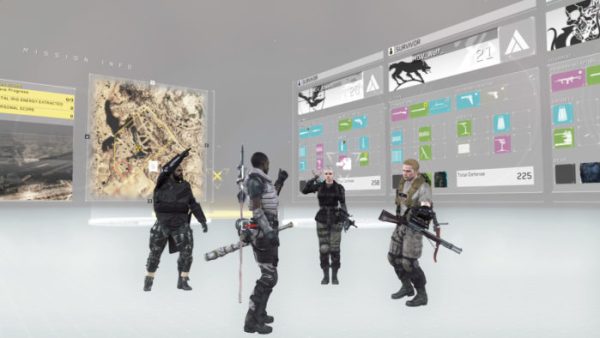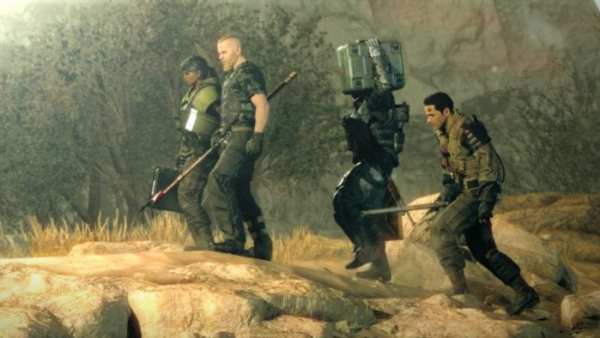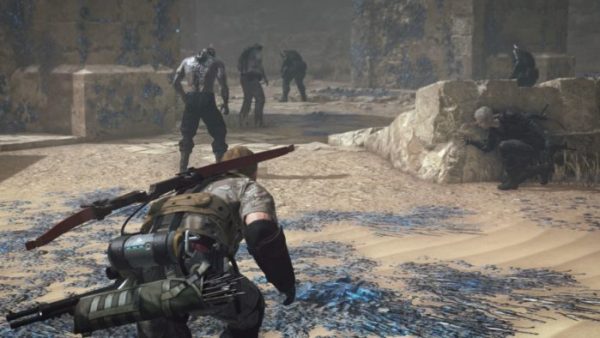Metal Gear Survive on PS4
When you ignore the shady underbelly of microtransactions and in-game purchases, Metal Gear Survive offers a fairly solid, if somewhat congested, survival game experience. It’s certainly not the best Metal Gear spin-off we’ve seen thus far – that honor goes to Acid – but it’s not completely horrible either. In fact, when you let yourself get truly immersed in the insipid and rote story Survive is trying to tell, the game does have its occasional flashes of brilliance.
As I mentioned in my review-in-progress, Metal Gear Survive’s story is pretty thin. The plot follows the mystery of how a wormhole mysteriously appeared over the MSF base after Cipher attacked, and players are then tasked with exploring the alternate dimension within the wormhole to find a cure for the infection that’s turning everyone into zombie-like Wanderers.
The first five hours of the single-player campaign are slow going. The game drops you into the heart of a desert wasteland with nothing but a few materials to craft a shoddy spear, and steadily dipping hunger and thirst meters that threaten to bring death upon you if you don’t do something about them soon. The initial story missions are laden with lengthy tutorials, tasking you with traveling to X location to bring back Y item. There’s only one enemy type in these missions – slow, shambling Wanderers that swipe at you aimlessly. Metal Gear Survive does spring a few more enemy variants on you near the end of the game, but by and large, your foes aren’t much of a challenge on their own.
As you trudge from one location to another, then back to your base camp again, you’re slowly eased into Survive’s core gameplay loop. Discover new areas that house more valuable materials, bring them back to camp, craft new equipment and weapons for yourself, then use the remainder to upgrade your base camp. In the middle of all this, don’t forget to hunt animals for raw meat and dig into watering holes for water as well. Soon, you’ll discover new methods of cultivating food and clean water that go beyond just scavenging. You’ll be able to boil your dirty water with a camp upgrade that makes it drinkable, and you’ll also discover farming, which lets you grow potatoes and corn. Considering how easy it is to hunt for animals and cook them, and the fact that it takes a few hours before you can harvest your crops each time, farming felt inconsequential for the most part. And it’s here that Metal Gear Survive’s systems begin to feel bogged down by unnecessary bloat.

Ammo needs to be crafted, whether you’re using bullets or old-fashioned arrows. You have to craft them back at base, so you’ll need to walk back to camp (or fast travel if you’re near a transporter) each time you’re low on supplies. There are primary and secondary types of weapons (though the difference between the two is never really made clear), and this determines the kinds of loadouts you can bring out with you. For instance, you can equip a bow and a machete at the same time, but you can’t do the same with a bow and a spear. Then there’s also your equipment weight to consider – carry too much, and your stamina drops faster.
Tying all of these little systems and mechanics together is the game’s dreadful UI. My goodness, the UI. Let’s talk about the UI.
First off, there’s a different workbench for every little thing you want to do. Want to craft a new hat? Go to the gear workbench. Want to get some steel fences? Go to the gadgets workbench. As you progress in the game, you get access to the advanced weapons workbench, but don’t forget to destroy that regular workbench first to save some space at camp. Getting anything done in Metal Gear Survive means diving headfirst into non-user-friendly menus. Tab icons are barely indicative of anything, you have to use the analog stick to choose your equipment slots when trying to finalize your loadout because the d-pad becomes unresponsive here for some reason, and having to go back and forth between your workbenches, base camp construction terminal, and your kitchen is just not fun.
Look, Metal Gear Solid V didn’t have a great user interface either, but at least everything was streamlined and easily accessible from the iDroid. We’ve got the exact same iDroid in Metal Gear Survive as well. Why can’t we use that to manage our gear and camp facilities?
Things aren’t much better when you head into the game’s co-op mode, where every single function is segmented into little circular areas you have to run into. Want to select a mission? Step into circle one, push a button, then choose your mission. Now, wait a couple seconds for the game to put you into matchmaking, then wait some more, then come back to the same clinically white staging area you were just in moments ago. Now, step into circle two a few meters away to actually start the mission.
Let’s not forget circles three and four either, if you want to level up and manage your equipment. Oh, and if you want to do some last minute crafting or cooking, go ahead and run to the other side of the staging area where the five different workbenches are waiting for you with their wonderfully unintuitive menus.

Thankfully, the moment-to-moment gameplay can be rather enjoyable once you get past all the tedium. The base-building element of Metal Gear Survive is compelling, especially when you start unlocking more facilities that you can construct around your little home away from Mother Base. Sure, the farms never really did me any good, but it was always fun to place them around my camp to give it more of a welcoming and homely look. The NPCs in Survive are dullards for the most part, but you can put them to work around camp by making them tend to the farms when you’re away.
Scavenging for resources, then coming back to improve my camp became my primary source of motivation for playing the campaign. There’s a lot of customization and variety available here, and Survive really does provide you with a great sense of accomplishment and progression as you continue to make new discoveries.
The co-op mode is every bit as fun as it was in the game’s pre-release betas. That is to say, they can feel shockingly unbalanced when you’re at a low level, but become much more enjoyable when you unlock new gear and class skills. Four low-level players would face off against level 20 Wanderers, making them ridiculously tough to take down, and causing you to die within two or three hits. This means that getting a decent rank in the Easy salvage missions is difficult, and the rewards are so minuscule that you’d be better off grinding levels in the campaign before even attempting co-op. Unless you’ve got a couple of high-level players who could carry you through to an S-rank. Even then, it won’t be fun.
Balancing issues aside, the salvage missions are rather exciting once you’re at the appropriate level for them. Figuring out choke points and optimal placement for your fences to block off the Wanderers is fun, and working together with your teammates to protect a wormhole generator from waves and waves of zombies is pretty satisfying. Resources obtained in co-op can only be used in co-op, and you’ll have to share them with your teammates, which means that everyone draws from the same resource pool when crafting. It’s just a shame that there aren’t more game modes available at launch, though Konami has already promised a new rescue mode coming in March. Konami has also made the baffling decision of carrying over your character’s hunger and thirst meters from the campaign. Since you can’t get food and water in co-op, you’ll need to make sure you’re well-stocked before entering the fray.
Surprisingly, the co-op mode isn’t really tied in with the story at all. In fact, because there isn’t much variety in the multiplayer side of things, the real focus of Metal Gear Survive lies in the single-player campaign where you’re more occupied with managing your character’s hunger and thirst, as well as the base-building elements. This makes Konami’s decision to enforce the always-online requirement even more peculiar, since the game is clearly meant to be enjoyed primarily as a solo experience.
Like I said way back at the start of the review, Metal Gear Survive’s story does have a few bright spots. If you can push yourself to keep wading through the poorly written plot and bland characters, the game offers up a few surprising twists to keep you engaged. The open world features a few areas completely shrouded in Dust, and this is where you’ll find the best resources in the game. There are also a few horrors lurking in here, such as a tentacled Lovecraftian eldritch abomination that’s introduced very early on in the story.
Indeed, the story starts to get a little more interesting as you approach its tail-end. Passionate Metal Gear fans might have noticed a few lore inconsistencies in the game’s earlier trailers, but most of these are explained away in the story itself. The answers aren’t terribly exciting or well thought out, but it’s something at least. There are a couple of great set-pieces and boss fights in the story that almost make you feel like you’re in a mainline Metal Gear game, as well as a twist near the end (coupled with an appropriately lengthy cutscene) to wrap up the whole campy story. Is the payoff satisfying enough to make up for the sluggish beginning and the sloppy plot? Well, not quite. But it’s there if you care enough about the survival gameplay to make it all the way through to the end.

Outside of the core game, it bears mentioning that Metal Gear Survive does feature microtransactions for those willing to shell out some real dollars for virtual goodies. For the most part, the microtransactions aren’t all that intrusive. You can pay money to get resource boosters and unlock more loadout slots, but they aren’t necessary, and you can definitely get through the game without having to spend a single cent. Where things get dicey, though, is when you find out that you have to pay $10 if you want to create a new character and start a new game without overwriting your old one.
Granted, Metal Gear Survive isn’t really the kind of game where you’d need multiple save slots. It’s a survival game with a few post-game activities you can engage in. The only reason you’d start over is if you want to experience the story all over again. Even so, Konami’s really dropped the ball here with this particular in-game purchase. Having multiple save slots or characters is a core part of any video game (MMOs notwithstanding), and it’s a basic function that you should have access to right from the start. Locking it behind a paywall feels all 50 shades of shady, and the bottom line is simply that players shouldn’t have to pay for the right to have multiple save files in what is predominantly a single-player game.
At the end of the day, Metal Gear Survive is still a decent game for fans of the survival/crafting genre, and people with a compulsive need to personalize their homestead and make it unique and their own. There’s plenty of fun to be had in the co-op mode as well, even if the user interface constantly feels like it’s working against you with all its annoying niggles. There are times where Survive shows signs of life, and its Metal Gear roots really seem to shine through. But then it’ll let you down with even more tiresome plot and new characters whose names you won’t remember.
Survive is a serviceable game, but its story and writing lack the one thing that drew fans to the series in the first place: heart.
Score: 2.5/5 – Poor
Pros
| Cons
|
For more information on how we review games, check out Twinfinite’s review policy here.
